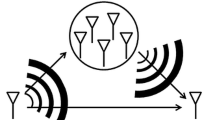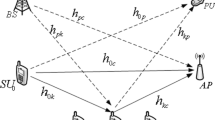Abstract
Cooperative communication will increase the channel capacity, when the communicating terminals exceed more than two. Therefore, a relay is termed, as three-terminal unit is a fundamental for user cooperation. The cooperation provides throughput enhancement, reliability, and coverage improvement for wireless communication. Relay technique plays a vital role in cooperative communication in terms of increasing coverage range as well as spectral efficiency. In existing techniques Amplify Forward increase the noise and Decode Forward increase the computational cost of the receiver. In order to overcome the above limitation, a hybrid adaptive relay technique is proposed for cooperative communication system, which will initially check the channel quality of the end user received SNR. When the receiver does not able to decode the message, then the user will choose relay signal. We derived a closed form expression to find the outage probability and channel capacity for the Rayleigh fading channel. Finally, simulation results show the performance of proposed adaptive relay technique in comparison with traditional relay technique by considering both perfect and imperfect CSI.







Similar content being viewed by others
References
Sung, C. K., & Collings, I. B. (2010). Decode-and-forward based cooperative transmission schemes for a relay with multiple receive antennas. In IEEE vehicular technology conference (Spring), 24 June 2010.
Lee, K. (2014). Novel decoding algorithms for decode-and-forward cooperative beamforming systems. IET Communications, 8(17), 3012–3018.
Liu, W.-C., & Liu, Y.-C. (2016). Performance analysis of relay selection with enhanced dynamic decode-and-forward and network coding in two-way relay channels. Information Theory, 20 Jan 2016. arXiv:1602.07943.
Sun, H., et al. (2017). Hop-by-hop relay selection strategy for multi-hop relay networks with imperfect CSI. IET Communications, 11(9), 1387–1395.
Karmakar, S., & Varanasi, M. K. (2011). The diversity-multiplexing tradeoff of the dynamic decode-and-forward protocol on a MIMO half-duplex relay channel. IEEE Transactions on Information Theory, 57(10), 6569–6590.
Mu, H., Tao, M., Dang, W., & Xiao, Y. (2009). Joint subcarrier-relay assignment and power allocation for decode-and-forward multi-relay OFDM systems. In IEEE communications and networking in China, 20 November 2009.
Yune, T.-W., Kim, D., & Im, G.-H. (2011). Opportunistic network-coded cooperative transmission with demodulate-and-forward protocol in wireless channels. IEEE Transactions on Communications, 59, 1791–1795.
Nasiri Khormuji, M., & Larsson, E. G. (2009). Cooperative transmission based on decode-and-forward relaying with partial repetition coding. IEEE Transactions on Wireless Communications, 8 ISSN: 1536-1276 02 May 2009.
Bai, Z., Jia, J., Wang, C.-X., & Yuan, D. (2015). Performance analysis of SNR-based incremental hybrid decode-amplify-forward cooperative relaying protocol. IEEE Transactions on Communications, 63, 2094–2106.
Liu, W.-C., & Chen, Y.-N. (2012). Dynamic decode and forward with network coding. In IEEE vehicular technology conference (Spring) 6–9 May 2012.
Duy, T. T., & Kong, H. Y. (2016). Performance analysis of mixed amplify and forward and decode and forward protocol in underlay cognitive networks. IEEE China Communications, 13(3), 115–126.
Attarkashani, A., & Hamouda, W. (2016). Joint power allocation and subcarrier-relay assignment for OFDM-based decode-and-forward relay networks. IEEE Communications Letters, 20(11), 2312–2315.
Zhang, B., Hu, J., & Huang, Y. (2015). Outage analysis of superposition-modulation-aided network-coded cooperation in the presence of network coding noise. IEEE Transactions on Vehicular Technology, 64(2), 493–501.
Forney, G. D., & Ungerboeck, G. (1998). Modulation and coding for linear Gaussian channels. IEEE Transactions on Information Theory, 44(6), 2384–2415.
Duy, T. T., & Kong, H.-Y. (2012). Performance analysis of hybrid decode-amplify-forward incremental relaying cooperative diversity protocol using SNR-based relay selection. IEEE Journal of Communications and Networks, 14(6), 703–709.
Author information
Authors and Affiliations
Corresponding author
Additional information
Publisher's Note
Springer Nature remains neutral with regard to jurisdictional claims in published maps and institutional affiliations.
Rights and permissions
About this article
Cite this article
S.B, L., S, M. A Hybrid Adaptive Relay Technique for Cooperative Communication System. Wireless Pers Commun 103, 2245–2258 (2018). https://doi.org/10.1007/s11277-018-5907-y
Published:
Issue Date:
DOI: https://doi.org/10.1007/s11277-018-5907-y




